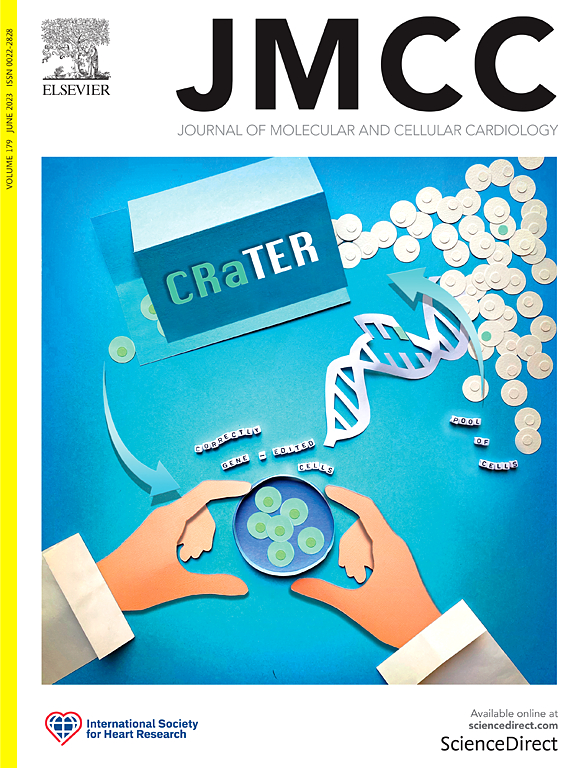Calcium binding to troponin C is required for activation of the myosin-containing thick filaments in rat cardiac trabeculae
IF 4.7
2区 医学
Q1 CARDIAC & CARDIOVASCULAR SYSTEMS
引用次数: 0
Abstract
Contraction of the muscular walls of the heart is driven by an interaction between myosin motors from the thick filaments and actin sites in the thin filaments. Each heartbeat is triggered by calcium binding to troponin in the thin filaments, which unblocks the myosin-binding sites on actin. The strength and speed of contraction is also modulated by the availability of myosin motors, which are sequestered in a helical array on the surface of the thick filaments between heartbeats. The signalling pathway controlling release of the motors from this array during the heartbeat is unknown, but there are three general hypotheses: thick-filament mechano-sensing, thin-to-thick filament signalling, and direct calcium signalling to the thick filament. Here we tested the third hypothesis by replacing the native calcium-binding subunit of troponin (TnC) with a variant which cannot bind calcium. Demembranated trabeculae from rat heart containing this variant generated no active force on addition of calcium. We measured calcium-induced release of myosin motors from the sequestered state by X-ray diffraction and from the orientation of fluorescent probes on the myosin regulatory light chain. Both methods showed the expected calcium-dependent changes in the conformation of the myosin motors in trabeculae containing native TnC, but all these changes were abolished in those containing the TnC variant that cannot bind calcium. We conclude that thick filament activation in rat heart trabeculae is not due to direct binding of calcium to thick filaments, but is mediated by calcium activation of the thin filaments by mechano-sensing or thin-to-thick filament signalling.

钙与肌钙蛋白C结合是激活大鼠心脏小梁含肌球蛋白粗丝所必需的。
心脏肌壁的收缩是由来自粗纤维的肌凝蛋白马达和来自细纤维的肌动蛋白位点之间的相互作用驱动的。每次心跳都是由钙与细纤维中的肌钙蛋白结合引发的,这就打开了肌动蛋白上的肌球蛋白结合位点。收缩的强度和速度也由肌凝蛋白马达的可用性来调节,肌凝蛋白马达以螺旋阵列的形式隔离在心跳之间的粗纤维表面。在心跳期间,控制马达从该阵列释放的信号通路尚不清楚,但有三种普遍的假设:厚丝机械传感、薄到厚丝信号和直接钙信号到厚丝。在这里,我们通过用一种不能结合钙的变体取代肌钙蛋白(TnC)的天然钙结合亚基来检验第三种假设。含该变体的大鼠心脏脱膜小梁在加钙时不产生活性。我们通过x射线衍射和荧光探针在肌球蛋白调节光链上的取向测量了钙诱导的肌球蛋白马达从隔离状态释放。两种方法都显示了含有天然TnC的小梁中肌球蛋白马达构象的钙依赖性变化,但在含有不能结合钙的TnC变体的小梁中,所有这些变化都被消除了。我们得出结论,大鼠心脏小梁的粗丝激活不是由于钙与粗丝的直接结合,而是由钙通过机械传感或细到粗的纤维信号激活细丝介导的。
本文章由计算机程序翻译,如有差异,请以英文原文为准。
求助全文
约1分钟内获得全文
求助全文
来源期刊
CiteScore
10.70
自引率
0.00%
发文量
171
审稿时长
42 days
期刊介绍:
The Journal of Molecular and Cellular Cardiology publishes work advancing knowledge of the mechanisms responsible for both normal and diseased cardiovascular function. To this end papers are published in all relevant areas. These include (but are not limited to): structural biology; genetics; proteomics; morphology; stem cells; molecular biology; metabolism; biophysics; bioengineering; computational modeling and systems analysis; electrophysiology; pharmacology and physiology. Papers are encouraged with both basic and translational approaches. The journal is directed not only to basic scientists but also to clinical cardiologists who wish to follow the rapidly advancing frontiers of basic knowledge of the heart and circulation.

 求助内容:
求助内容: 应助结果提醒方式:
应助结果提醒方式:


